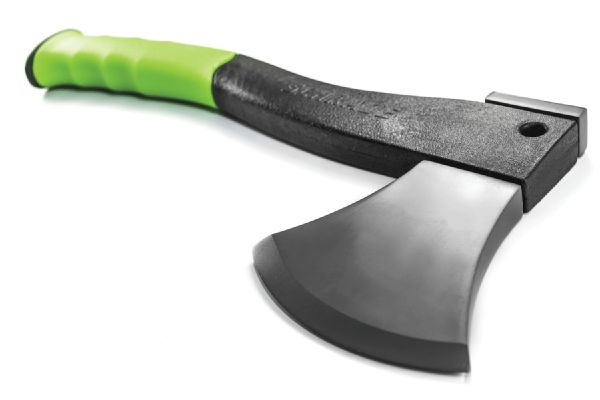Schrade SCAXE2G Extreme Survival Hatchet Reviewed
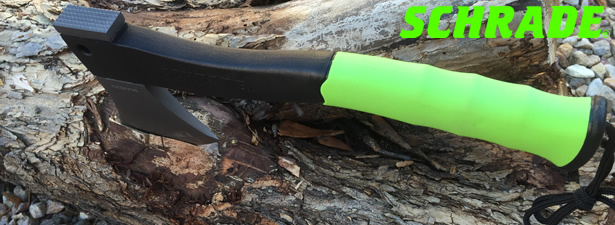
Marketing from Schrade
Measuring 11.8 inches from end-to-end, the Schrade Extreme Survival Hatchet is an excellent choice for a variety of outdoor applications — including camping and wilderness survival. The hatchet blade is made of titanium-coated 3Cr13 stainless steel and will effectively resist rust. The blade is large enough for aggressive cutting and chopping, but small enough for finer work in the backcountry. Additionally, you’ll find a textured pommel on the rear of the axe, useful for many tasks like breaking or hammering.
The black glass fiber-filled PA handle is contoured for comfort and strong, positive control. The lower-portion of this model’s handle is a TPR rubberized luminescent grip, which will glow green in low-light situations if it was earlier exposed to light. This feature makes it notably easier to locate the hatchet around camp at night.
Housed in the bottom of the handle is a 4-inch ferro rod. Remove it easily by pulling on the attached lanyard, scrape off the black coating, and ferro rod is ready for use to start a fire.
Manufacturer: Schrade, www.schrade.com
Model: SCAXE2G
Overall Length: 11.8″ (30.0 cm)
Blade Steel: Titanium Coated 3Cr13 Stainless Steel
Blade Length: 3.8″ (9.6 cm)
Handle Material: Black Glass Fiber Filled PA w/ Phosphorescent Green TPR Rubber Grip
Grip Length: 5.2″ (13.2 cm)
Weight: 1.37 lbs (23.4 oz)
Accessories: XL Ferro Rod, Thermoplastic Sheath
Warranty: Limited Lifetime Warranty against any manufacturing defects
UPC: 044356219143
MSRP: $56.64
The Review
After reviewing Schrade’s SCAXE2L last year, I was thrilled to have the opportunity to put the smaller SCAXE2G through its paces. As my quest for quality packable gear continues, the delicate balance between affordability, durability, functionality, weight, and volume has become much more important. Now lets take the SCAXE2G for a spin…
Initial Thoughts
The SCAXE2G has a titanium-coated 3Cr13 stainless steel head protected by a rugged thermoplastic sheath, a black glass-reinforced handle with a bright phosphorescent green TPR rubberized grip that jumps out at you, and tucked neatly inside the base of the handle there is a large ferro rod connected to a lanyard.
After spending some time messing around with the SCAXE2G, I found it to be well-balanced sized perfectly for single-handed operation. There is plenty of weight behind each strike, yet it’s light enough to pack and wield without undue fatigue. It is even very comfortable to choke up for fine work.
The SCAXE2G came sharp right out of the box. This is one thing that I especially love about Schrade products. They always arrive sharp and ready to go. Although, I did notice that the grind bevel is off from one side to the other. As a result, each side of the bit and cheeks are not symmetrical. This is certainly fixable with a little effort, and likely just a simple Quality Control oversight.
Features
Now lets look at the SCAXE2G’s features in more detail…
The Axehead
The SCAXE2G’s axehead is constructed from titanium-coated 3Cr13 stainless steel with a sharpened 3.8″ blade. 3Cr13 stainless steel is a very good alloy for an axehead because it is relatively easy to sharpen and holds an edge extremely well. However, 3Cr13 Stainless Steel is only rust resistant, not rust proof. Even with the protective Titanium coating, it is still susceptible to rust without proper care and maintenance. If the blade becomes wet, simply dry it thoroughly and lightly coat it with an oil like Break-Free CLP before storage. If you do, it just might last you a lifetime.
The SCAXE2G butt-end (poll) of the axehead has an aggressively milled non-slip hammer pommel for hammering anything from nails to tent stakes, or even crushing rocks.
The Handle
The stainless steel axehead is fused onto a contoured 11.8″ black, glass-fiber filled PA handle with an ergonomic 5.2″ bright phosphorescent green TPR rubberized grip. The luminescent grip will glow green in low-light situations making it easy to locate around camp provided it has recently been exposed to light.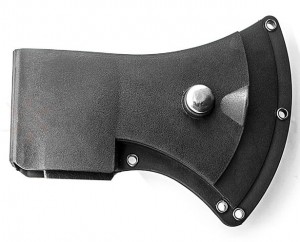
TPR is basically a Thermoplastic Elastomer similar to that of TPE, making it a perfect choice for a handle grip. The TPR surface provides a comfortable, non-slip surface, even in wet conditions. Additionally, the soft TPR material will absorb some of the vibration coming from the axe head as it strikes hard surfaces, thus reducing fatigue.
Schrade’s SCAXE2 series hatchets are not only available with the phosphorescent green handle, they are also available in bright orange (SCAXE2O), and in a stealth black (SCAXE2).
The Sheath
The SCAXE2G axehead comes protected by a thermoplastic belt sheath. A snap on the front secures the hatchet firmly in place. A quick tug on the snap allows for rapid deployment. A belt loop is molded onto the back of the sheath that is capable of supporting a belt up to 2″ wide. Additionally, there are five grommet holes providing numerous carry options.
Accessories
The SCAXE2G comes with an extra-large 4″ ferro rod with a lanyard tucked neatly inside the handle. The ferro rod is an excellent size and quality, providing an ample amount of heat and spark with each strike. Perfect for getting a fire going quickly.
Functional Testing
Now lets see what Schrade’s SCAXE2G can do… In order to provide a some semblance of an apples-to-apples comparison between axes and hatchets, I will be performing four durability and fine-control tests; Chopping, Log Splitting, Feather Stick and Edge Retention. In a survival situation, all resources are fair game. However, since I am not in a life-or-death situation, I’ll stick to some seasoned logs that I have lying around for these tests. I thoroughly recommend wearing eye protection and a good pair of gloves to protect your hands and absorb some of the vibration.
Chopping
The first test for the SCAXE2G is to try my hand at delimbing a few long branches and limbs, then chop them into a manageable size like those you would use to build a simple shelter or to create a stockpile of firewood for getting through a cold evening in the bush. Likely as close as I can get to a real-world situation.
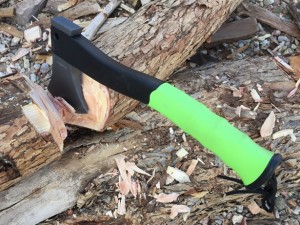 Delimbing the larger branches and stripping the foliage was quick and easy. The SCAXE2G made quick work of all smaller material around 1-2″ in size without much effort. Many with nothing more than a single swing.
Delimbing the larger branches and stripping the foliage was quick and easy. The SCAXE2G made quick work of all smaller material around 1-2″ in size without much effort. Many with nothing more than a single swing.
When bucking material larger than a few inches in diameter you simply strike the log at a 45° angle from two perpendicular directions along the cut-line, effectively making a “V” where the material used to be otherwise known as the kerf. The kerf should equal the diameter of the trunk, and when cutting from both sides, the kerf would essentially be half diameter.
The larger material obviously required a bit more effort, but the SCAXE2G did a fine job. At a little less than 12″ in length and total weight of 23.4 ounces, the SCAXE2G provides an ample amount of striking force for a small packable survival hatchet. I was thoroughly impressed with the SCAXE2G. It performed very well at this task, though it wouldn’t be my first choice for building a log cabin.
Log Splitting
After bucking a few branches into short pieces, the next logical thing to do was to split them into kindling which brings us to part one of this functional challenge.
A word of caution when performing a task like this… It can be very dangerous with a short axe or hatchet. Make sure never to break the vertical plane rule. Avoid any condition where the axe could swing beyond its vertical plane without hitting something other than your leg first. This task is best performed safely from the ground-level, and not from high-up on a stump. Simply place the log you are sectioning on the ground, and kneel in front of it as you section it off.
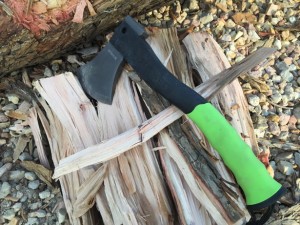 I began this part of the test by placing a log vertically and striking the end. The SCAXE2G axehead is shaped nicely for log splitting. The aggressive angle of the blade’s edge and cheeks forces the log to split quick and easy. I was able to split a few 5-6″ logs without much effort. In some cases with a single swing, and others required the use of a baton to help get it through. But all in all, the SCAXE2G worked like a champ.
I began this part of the test by placing a log vertically and striking the end. The SCAXE2G axehead is shaped nicely for log splitting. The aggressive angle of the blade’s edge and cheeks forces the log to split quick and easy. I was able to split a few 5-6″ logs without much effort. In some cases with a single swing, and others required the use of a baton to help get it through. But all in all, the SCAXE2G worked like a champ.
For part two of this challenge, I chose to split a stump approximately 8″ diameter and a little more than 12″ tall. Now the SCAXE2G is much too small to quarter large-diameter material, as with any small hand axe or hatchet. You simply cannot use the same method as you would splitting logs 6″ or smaller, even with a baton. The exercise would be futile and makes no sense. Quartering large-diameter material is really a job for a wedge or splitting maul. However, you can turn it into a bunch small pieces.
To properly split larger material like this with a hand axe or hatchet, you still strike the axehead against the top edge of the stump, just not perpendicular to the rings. Instead, you align the blade parallel to the rings. As a result, you are only removing small sections of the log, just an inch or two thick and maybe 3-4″ wide. As you work your way around the log the diameter will continue to decrease, getting smaller and smaller until it is finally quarterable.
When it comes to a compact packable hatchet turning large material into small material, the SCAXE2G is very capable and well-suited for the task. It is small enough for single-handed operation, but long enough to be used with two hands when you need a little extra power. As long as you are not too aggressive with the amount of material you are trying to section off, the SCAXE2G will do the job well. If you run into trouble getting through the material, just reduce the size of the section a little.
Feather Stick
Per Wikipedia: A feather stick (sometimes referred to as a fuzz stick) is a length of wood which is shaved to produce a head of thin curls protruding from the wood. It is used for damp wood to start a fire (or campfire) when dry tinder is hard to find.
The functional challenge that shows off a blade’s edge and provides some insight into how well it can perform other fine bushcraft tasks is without a doubt feathering a stick.
To demonstrate feathering a stick with the SCAXE2G I used a stick about 1″ in diameter and about 16″ in length. I began by shaving off the bark from about 8″ of the way up the stick exposing the wood grain. Once the bark had been removed, I started to work my way around the stick with long 6″ strokes near the bottom-end of the stick. I was creating finely shaved curls otherwise known as “feathers”.
 I found that gripping the handle against the bottom of the axehead with my index finger resting on the cheek of the axehead to be the sweet-spot for providing the best control when feathering a stick. Additionally, I rested the grip-end of handle against my thigh to increase my control over the hatchet.
I found that gripping the handle against the bottom of the axehead with my index finger resting on the cheek of the axehead to be the sweet-spot for providing the best control when feathering a stick. Additionally, I rested the grip-end of handle against my thigh to increase my control over the hatchet.
As I worked my way around the stick, I tried not to dig in too deep causing them to break before I made it to the end of the stick. When I was done, I had a pile of shavings ready to create a fire. As expected, the SCAXE2G performed fairly well at this task. A good survival knife is certainly better suited for this kind of fine bushcraft. However, in a pinch the SCAXE2G will certainly get the job done.
Edge Retention
After all of the functional tests had been completed, the SCAXE2G remained as sharp as when I began, cleanly slicing through a single sheet of paper without issue. Additionally, there were no sign of cracks, chips or imperfections of any kind with the exception of some wear on the blade’s protective coating. The SCAXE2G held its edge and remained very sharp the entire time, even with all of the punishment that I threw at it.
Final Thoughts
Schrade’s SCAXE2G is a rugged survival hatchet designed with the outdoor enthusiasts and wilderness survival in mind. Certainly tough enough to get the job done, even under the most extreme survival conditions. Like Schrade’s SCAXE2L last year, I really enjoyed putting the smaller SCAXE2G to the test. It is a rock-solid performer as well, perfect for turning large material into small material.
The SCAXE2G is compact, lightweight, versatile, and easily packable with a number of various carry options. It is extremely comfortable to wield with or without gloves and very well-balanced providing excellent control for intricate notching and shaping of material. A necessity when fitting material tightly together for use in building shelters and other bushcraft projects.
The 3Cr13 stainless steel axehead and glass-reinforced handle are rust resistant and built last. At around $35, you really get a lot of bang for your buck. Therefore, if you are prepping on a budget, the SCAXE2G provides quite a lot of value. You can purchase four or five of them for the same cost as one of the high-end alternatives, and likely never discover any of the benefit.
Even with the non-symmetrical grind on the axehead that I received, the off-angle did not seem to affect its performance whatsoever. If it begins to bother me any, I’ll likely just correct the angle on the grinder. I really do like the SCAXE2G and I plan to add this one to my bug-out gear for sure. Though if I do pick up another, I’d probably opt for the stealthy all black SCAXE2. Thumbs up Schrade!
You can find this and other Schrade products here: http://amzn.to/2c0kjZF
![]()
About Taylor Brands and Schrade Cutlery
 Founded by Stewart Taylor in 1975, Taylor Brands has been manufacturing, designing, and distributing high-quality stainless steel cutting tools and accessories since our inception. Taylor Brands owns and produces Schrade, Old Timer, Uncle Henry, and Imperial branded products, and are also licensed to produce multiple product lines under the world famous Smith & Wesson brand. In total Taylor Brands manufactures several hundred different products including fixed and folding knives, collapsible batons, tactical pens, handcuffs, tactical and survival accessories, and flashlights.
Founded by Stewart Taylor in 1975, Taylor Brands has been manufacturing, designing, and distributing high-quality stainless steel cutting tools and accessories since our inception. Taylor Brands owns and produces Schrade, Old Timer, Uncle Henry, and Imperial branded products, and are also licensed to produce multiple product lines under the world famous Smith & Wesson brand. In total Taylor Brands manufactures several hundred different products including fixed and folding knives, collapsible batons, tactical pens, handcuffs, tactical and survival accessories, and flashlights.
--
